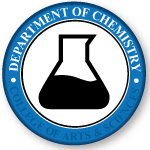Document Type
Monograph
Publication Date
6-20-2019
Publication Title
Advances in Applied Science and Technology
Volume
3
First Page
13
Last Page
26
Abstract
Aims: To demonstrate an analysis for vitamin B6 from commercial aqueous nutritional drinks and solid tablets, utilizing isocratic conditions with high performance liquid chromatography (HPLC) and UV detection at 290 nm. Study Design: Vitamin B6 in the form of pyridoxine hydrochloride is assayed by HPLC from various samples. Place and Duration of Study: Department of Chemistry, Durham Science Center, University of Nebraska, Omaha Nebraska from May to August 2016. Methodology: Utilizing a reversed-phase C-18 column with eluent solvent (19% ethanol, 77% water, 4% acetic acid), the samples were prepared in sample solvent (19% ethanol, 81% distilled water). Detection of vitamin B6 was accomplished at 290 nm. Analysis of samples was done following solubilizing in aqueous conditions having ethanol at 10% to 20% (v/v). Column pressure at 1900 psig, rise time 0.1 with flow rate 1.0 mL/minute. Elution peak for vitamin B6 occurred consistently at 1.6 minutes. Nutritional samples, aqueous samples, and solid pills were prepared in aqueous solvent with various levels of ethanol. Results: Levels of vitamin B6 detected were as low as 4.4029x10-5 molar to 7.8081x10-4 molar. Sensitivity for vitamin B6 was highest at 290 nm. Reverse phase isocratic conditions is shown to be effective for determination of vitamin B6 in aqueous based samples. Standard curves applied are highly linear in range from zero to 7.8081x10-4 molar (y = 112,521,145.5x + 2,818.6), having coefficient of determination (R2 = 0.9948) with very strong positive correlation coefficient (r= 0.9974). Percent recovery of vitamin ranged from 95% to 105%. Amounts of vitamin present in drinks from same manufacturer were consistent. Conclusion: Utilizing reversed phase column, isocratic solvent conditions with ethanol in water, and a UV detector set at 290 nm is effective for determination of vitamin B6. Ethanol-water solvent system is effective. Vitamin B6 was found in various amounts in nutritional drinks tested. Percent recovery of vitamin averaged 101% with a standard deviation of 2.4%. Pyridoxine hydrochloride was effectively assayed from aqueous samples, vitamin preparations, and vitamin tablets. The methodology presented in this study will be useful for quality control analysis for commercial production. Analysis methods for vitamin assay are a necessary objective to ensure quality control of commercial products and medicinal applications.
Recommended Citation
Bartzatt, R., Gajmer, P., Nguygen, M.H.C., & Tran, A.M. (2019, June 20). Chapter 2: Assay of Vitamin B6 (Pyridoxine Hydrochloride) Utilizing Isocratic Reversed Phase High Performance Liquid Chromatography. In Tuzemen, S. & Khan, F. Eds. Advances in Applied Science and Technology, Vol. 3, pp 12-26. https://doi.org/10.9734/bpi/aast/v3
Creative Commons License

This work is licensed under a Creative Commons Attribution-No Derivative Works 4.0 License.


Comments
This is Chapter 2 in the book Advances in Applied Science and Technology, Vol. 3, Tuzemen, S. & Khan, F. Eds. This book was published under a Creative Commons License CC BY, but the publisher recommends a CC BY NC ND license. Authors retain copyright. https://doi.org/10.9734/bpi/aast/v3